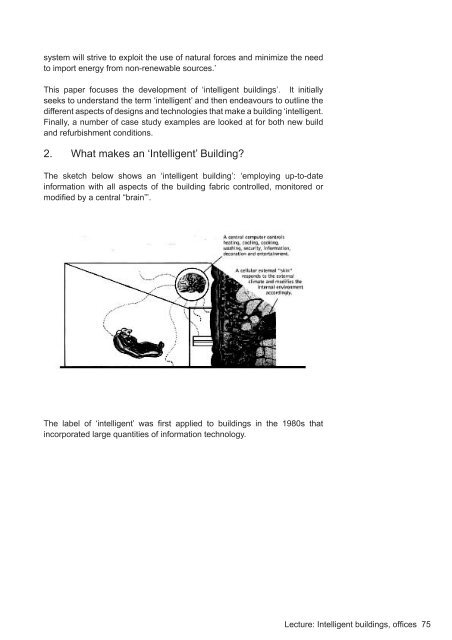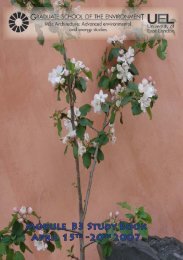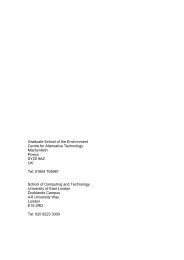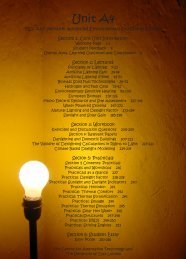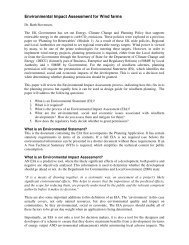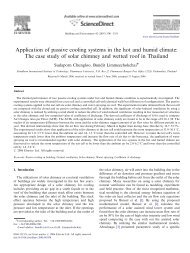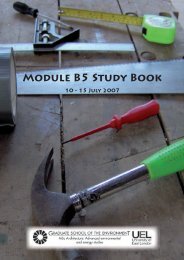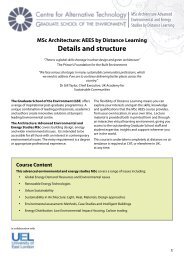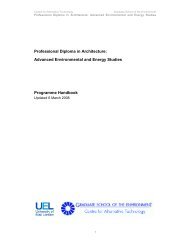- Page 1 and 2:
Module B1 Study Book Section 1: Cor
- Page 3 and 4:
Section 1: Core Module Information
- Page 5 and 6:
A warm welcome to the new students;
- Page 7 and 8:
Student Feedback Analysis The follo
- Page 9 and 10:
work was done. The marks allocated
- Page 11 and 12:
5. Is any unfairness justified by t
- Page 13 and 14:
Lecture: Energy Futures Paul Allen
- Page 15 and 16:
are not developed fast enough There
- Page 17 and 18:
with some coal in Europe, Asia, and
- Page 19 and 20:
tell exactly which day we will get
- Page 21 and 22:
We must integrate our science and p
- Page 23 and 24:
Features Consequences Impacts Table
- Page 25 and 26: disposal (recycling, landfill, inci
- Page 27 and 28: 9. Community 10. Business A series
- Page 29 and 30: Background The Building Research Es
- Page 31 and 32: Weighting of Environmental Issues 3
- Page 33 and 34: 10 visual comfort 11 olfactory comf
- Page 35 and 36: ESI-3: Net annual consumption of pr
- Page 37 and 38: EcoHomes. 3.9.3 PROPOSED FUTURE REQ
- Page 39 and 40: • The removal of two location spe
- Page 41 and 42: Environmental impact of materials R
- Page 43 and 44: 8. Sustainable construction - waste
- Page 45 and 46: Lecture: Nuclear power Damian Randl
- Page 47 and 48: ) Fission reactors: the basics For
- Page 49 and 50: The core of a PWR, an open lattice
- Page 51 and 52: a) Mining and extraction 75,000 ton
- Page 53 and 54: further use. Optimists have suggest
- Page 55 and 56: ) The economics of nuclear have bee
- Page 57 and 58: wastes deep underground in Britain
- Page 59 and 60: A bigger step is proposed by the Hi
- Page 61 and 62: The evidence of the British Nuclear
- Page 63 and 64: energy efficient as a nation and de
- Page 65 and 66: 5. Is any unfairness justified by t
- Page 67 and 68: elates to the gradual reduction of
- Page 69 and 70: The total of 335 million tonnes in
- Page 71 and 72: of the waste management industry. T
- Page 73 and 74: the targets, where the baseline is
- Page 75: criteria for the collection, treatm
- Page 79 and 80: This building, the workplace of som
- Page 81 and 82: Energy Consumption Figures: • Act
- Page 83 and 84: Main aspects of the project include
- Page 85 and 86: (i.e. proportions of windows and op
- Page 87 and 88: • Reduction in heat gains from li
- Page 89 and 90: transmission lines. It was complete
- Page 91 and 92: Distribution The Area Boards in Eng
- Page 93 and 94: generation of electricity rose by 8
- Page 95 and 96: electricity demand. The Grid and re
- Page 97 and 98: Source: IEA report • "The maximum
- Page 99 and 100: Time and power rating of various el
- Page 101 and 102: Reducing output from a source that
- Page 103 and 104: In practice: • now around 5% of t
- Page 105 and 106: enewables. In the UK, Ofgem has app
- Page 107 and 108: a) System regulatory barriers: what
- Page 109 and 110: customers of existing electricity s
- Page 111 and 112: http://www.sussex.ac.uk/sussexenerg
- Page 113 and 114: issues of ‘sustainable’ develop
- Page 115 and 116: Towards the Planning White Paper 20
- Page 117 and 118: There is feeling amongst some archi
- Page 119 and 120: eight weeks, but can often take muc
- Page 121 and 122: eaching implications to both budget
- Page 123 and 124: white goods (fridges, washing machi
- Page 125 and 126: and Resources Action Programme (WRA
- Page 127 and 128:
Edwards, S (2003) Principle Consult
- Page 129 and 130:
Lecture: Getting Something Built Pa
- Page 131 and 132:
trade contractor to start and futur
- Page 133 and 134:
Section 3: Relevant Papers Waste Mi
- Page 135 and 136:
industry has placed waste reduction
- Page 137 and 138:
The trend in the design constructio
- Page 139 and 140:
minimising environmental impact (in
- Page 141 and 142:
ordination. Building Services Journ
- Page 143 and 144:
this threat that is real and yet in
- Page 145 and 146:
obliged now to begin planning for t
- Page 147 and 148:
and plant species ― from bacteria
- Page 149 and 150:
oil and natural gas, and some coal)
- Page 151 and 152:
challenging to determine what the h
- Page 153 and 154:
Just as it is morally obligatory to
- Page 155 and 156:
The cultures and religious traditio
- Page 157 and 158:
since they will depend upon their n
- Page 159 and 160:
20 Michael McCarthy, The Independen
- Page 161 and 162:
Heinberg, Richard. Powerdown: Optio
- Page 163 and 164:
2003 Green Building Costs and Finan
- Page 165 and 166:
How much more do green buildings co
- Page 167 and 168:
The Report calculates these additio
- Page 169 and 170:
A 1% increase in productivity (equa
- Page 171 and 172:
Figure 3 Financial Benefits of Gree
- Page 173 and 174:
Paper: Advanced Interactive Facades
- Page 175 and 176:
engaging an industry consortium in
- Page 177 and 178:
3. STATE-OF-THE-ART IN EUROPE AND U
- Page 179 and 180:
analyzed under a range of diverse c
- Page 181 and 182:
4.4 Innovation will improve hardwar
- Page 183 and 184:
The environmental rationale appears
- Page 185 and 186:
Student Essay: Ishaq Muhammad Unit:
- Page 187 and 188:
Source: MidTherm Limited-www.midthe
- Page 189 and 190:
Analysis The Dining Hall has slopin
- Page 191 and 192:
equired. Night-time cooling: Yes Oc
- Page 193 and 194:
temperature within the educational
- Page 195 and 196:
(Sullivan, 2006). This means the in
- Page 197 and 198:
Great Britain. DfES. (2006). Buildi
- Page 199 and 200:
• to pump the water through the p
- Page 201 and 202:
and energy efficiency. So people bu
- Page 203 and 204:
Apart from energy labelling, there
- Page 205 and 206:
what is worse, it is possible to re
- Page 207 and 208:
Tacoma Power, Tacoma Public Utiliti
- Page 209 and 210:
Air Blowers: Some spas are equipped


